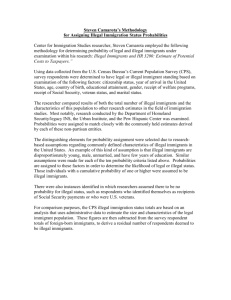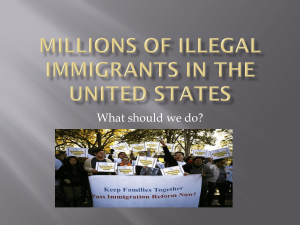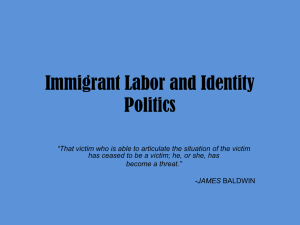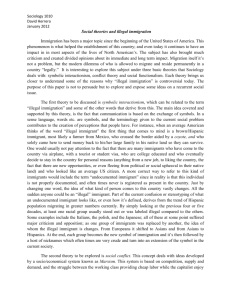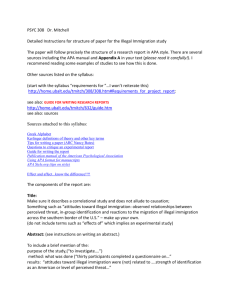Illegal Immigration: Economic, Social and Ethical Implications
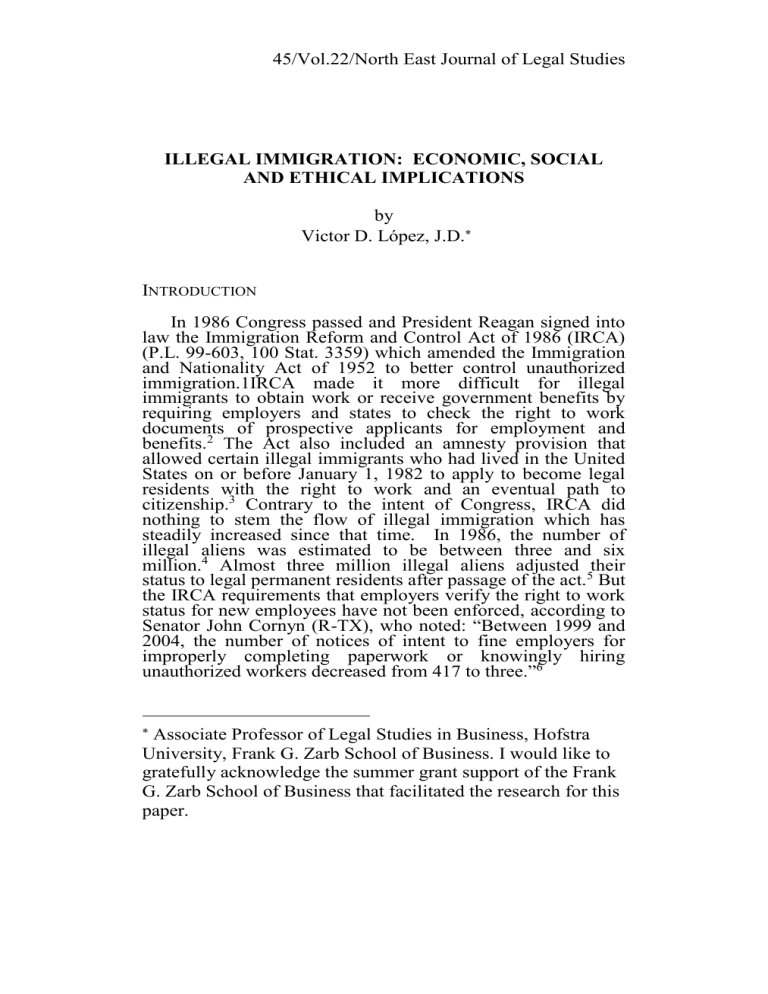
45/Vol.22/North East Journal of Legal Studies
ILLEGAL IMMIGRATION: ECONOMIC, SOCIAL
AND ETHICAL IMPLICATIONS by
Victor D. López, J.D.
I
NTRODUCTION
In 1986 Congress passed and President Reagan signed into law the Immigration Reform and Control Act of 1986 (IRCA)
(P.L. 99-603, 100 Stat. 3359) which amended the Immigration and Nationality Act of 1952 to better control unauthorized immigration.1IRCA made it more difficult for illegal immigrants to obtain work or receive government benefits by requiring employers and states to check the right to work documents of prospective applicants for employment and benefits.
2
The Act also included an amnesty provision that allowed certain illegal immigrants who had lived in the United
States on or before January 1, 1982 to apply to become legal residents with the right to work and an eventual path to citizenship.
3
Contrary to the intent of Congress, IRCA did nothing to stem the flow of illegal immigration which has steadily increased since that time. In 1986, the number of illegal aliens was estimated to be between three and six million.
4
Almost three million illegal aliens adjusted their status to legal permanent residents after passage of the act.
5
But the IRCA requirements that employers verify the right to work status for new employees have not been enforced, according to
Senator John Cornyn (R-TX), who noted: “Between 1999 and
2004, the number of notices of intent to fine employers for improperly completing paperwork or knowingly hiring unauthorized workers decreased from 417 to three.” 6
Associate Professor of Legal Studies in Business, Hofstra
University, Frank G. Zarb School of Business. I would like to gratefully acknowledge the summer grant support of the Frank
G. Zarb School of Business that facilitated the research for this paper.
2009/Illegal Immigration/46
After much contentious debate, the latest efforts at immigration reform 7 proposed by President George W. Bush died in the Senate last June. The following reported comments by William King Jr., former Western amnesty program director for the Immigration and Naturalization Service (INS), are typical of those who opposed the most recent immigration reform efforts: “I just can't believe they're trying to do this again . . . . We seem to be suffering from collective amnesia about why amnesty programs have never and will never work.
They're using the same language, the same logic and, I assure you, will reach the same conclusion: failure."
8
The Department of Homeland Security (DHS) estimates that there were approximately 11.6 million unauthorized immigrants in the United States by January 2006.
9 The existence of these uninvited guests poses vital and difficult political, social, economic and ethical issues for policymakers that need to be addressed and will only worsen in the future through a continued policy of benign neglect. Rather than patterning new policy after the failed policies of the past,
Congress and the President need to reexamine and address the issue undistracted by the advocates on both sides of the issue that have the best interest of their constituencies rather than basic fairness, justice or the good of the country in mind. This may be a difficult task to take on in an election year in which control of both houses of Congress and the White House are in play. Rather than stitching together a politically palatable piece of legislation from the frayed cloth of failed past legislation, our political leaders might do well to evaluate the cause and effect of illegal immigration with fresh eyes and as a part of our overall immigration policy in order to find a solution to the problem of illegal immigration that is consistent, fair, and sustainable. The first step in searching for a solution to the problem will require a reexamination of current immigration policy from a variety of perspectives and a willingness to endure the criticism of advocates who have a personal stake in shaping our immigration policy to serve their clients’ needs or the interests of the groups they represent and who might be discomfited by the examination of data or new proposals they view as hostile to their ends.
47/Vol.22/North East Journal of Legal Studies
I.
T
HE
N
EED TO
D
ISTINGUISHING
B
ETWEEN
L
EGAL AND
I LLEGAL I MMIGRATION
The public debate relating to illegal immigration has been widely and inaccurately portrayed as an immigration debate in the popular media. The term “illegal immigration and “illegal alien” in fact has largely disappeared from the public lexicon, if not from scholarly writing or the language of the law, and has been replaced by the terms “undocumented immigrant” or more commonly “undocumented worker.” This removes the pejorative connotations of the former terms, and the stigma that may attach to those whom they describe, but also serves to deemphasize the fact that these individuals have violated our laws and have no right to be here. And it allows advocates of illegal immigrants to paint those who call for measures to discourage illegal immigration enforce existing laws or oppose broad-based amnesty proposals as “anti immigrant.” Legal and illegal immigration are unrelated issues that must be treated separately in any honest debate.
II.
T
HE
E
CONOMIC
I
MPACT OF
I
LLEGAL
I
MMIGRATION
A report published by the Congressional Budget Office
(CBO) in December 2007 finds that “The tax revenues that unauthorized immigrants generate for state and local governments do not offset the total cost of services provided to those immigrants.” 10 The report found that “almost 90 percent of unauthorized immigrants lived in six states: California,
Florida, Illinois, New Jersey, New York and Texas.” 11
The
CBO report concentrated on three areas of expenditures for states in which states have limited options for controlling costs in the areas of education, health care and law enforcement.
12
According to the Federation for American Immigration Reform
(FAIR) the cost of illegal immigration to American taxpayers is estimated to be $45 billion per year after accounting for the taxes paid by illegal aliens.
13
The Center for Immigration
Studies (CIS) estimates the cost of illegal immigration to the federal government to be $10.4 billion per year.
14
In addition, the willingness of illegal immigrant’s to work for sub-par wages can have a deflating influence on salaries that is difficult to calculate.
Despite the often repeated line in the business community that illegal workers largely perform jobs that Americans who
2009/Illegal Immigration/48 are authorized to work are unable or unwilling to do
15 undocumented workers in fact perform jobs across a wide range of industries in which they compete with legal immigrants and citizens. According to a report from the Pew
Hispanic Center, “there are a total of 7.2 million unauthorized workers in the U.S. who make up nearly 5% of the total workforce.” 16
According to the report, construction and the leisure and hospitality industries make up “about 40% of all short-term unauthorized workers, and other major industries with large numbers of unauthorized workers include professional and business services, mainly building maintenance, cleaning and landscaping, (350,000), manufacturing (340,000), wholesale and retail (270,000), education and health services (125,000) and agriculture
(110,000).” 17
Given that the unemployment rate reported by the
U.S. Department of Labor (DOL) in December 2007 is five percent
18
and that illegal aliens represent nearly five percent of the total workforce, it seems clear that illegal immigrants are taking a significant number of jobs that would otherwise be filled by American citizens and legal immigrants. It seems equally clear that the diminished pool of employment opportunities for unemployed legal residents, especially for those with limited skills and education who compete for a finite number of jobs with illegal immigrants, places an additional drain on federal, state and local resources on all forms of available public assistance for citizens and legal immigrants displaced by illegal immigrants. This cost is difficult to quantify and is not normally factored as a cost of illegal immigration, though it results directly from it.
Another way in which illegal immigrants have a negative impact on the economy that is not readily measurable is in the foreign remittances that they make to help support their families in their countries of origin. While the income that
American workers earn is usually spent, saved and invested in the United States, thus helping to sustain and fuel economic growth in this country, significant amounts of income earned by immigrants (both legal and illegal) is sent out of the country thus helping the economies of their countries of origin.
Mexico’s central bank reported that remittances from Mexicans living in the U.S. reached $20 billion in 2005, of which $2 billion was walked across the border as cash by returning migrants and $18 billion was sent from the U.S. in the form of money transfers.
19
49/Vol.22/North East Journal of Legal Studies
Reliable numbers relating to actual taxes paid by illegal immigrants are difficult to find, though “researchers generally agree that 50 to 60 percent of illegal immigrants nationwide work for employers who withhold income taxes and Social
Security and Medicare payments from their paychecks,” 20
but
“[t]he other 40 to 50 percent of illegal immigrants are paid under the table, researchers say.” 21
III.
I LLEGAL I MMIGRATION AND P UBLIC H EALTH
Legal immigrants to the U.S. are required to undergo medical examinations and vaccinations and can be denied entry for health reasons.
22
Illegal immigrants who cross the seven thousand miles of common borders with Canada and Mexico, or who land on our thousands of miles of coastline, are not subject to any health screening and can pose serious health risks to U.S. citizens and legal residents. For example, the
Centers for Disease Control and Prevention (CDC) lists
Mexico and all of Central and South America, the Caribbean,
Africa, the Middle East, Greenland and parts of Asia as high risk areas for contracting Hepatitis A
23
and lists parts of
Canada, Mexico, Central and South America, Africa, Europe, the Middle East, Greenland and Asia as moderate or high risks for hepatitis B.
24 Nigeria, India, Pakistan, and Afghanistan remain polio-endemic, according to the CDC with importation in the past 6 months of the disease to Angola, Burma
(Myanmar), Chad, the Democratic Republic of the Congo
(DRC), Niger, and Sudan.
25 Of these countries, DRC and
Burma (Myanmar) had previously been polio-free for over 5 years.
26
Add to these currently reported outbreaks of mumps and measles in various parts of the world, antibiotic resistant tuberculosis, Ebola, avian influenza, AIDS and sundry other communicable diseases
27
and the potential health risks posed those who enter the country illegally by crossing the porous borders without being subjected to health examinations is clear.
Although the federal government does not provide
Medicaid or Medicare benefits to illegal aliens, U.S. law requires hospitals to treat anyone who needs emergency care, regardless of their ability to pay or immigration status.
28
A
2006 University of Texas at El Paso (UTEP) study found that
“border counties have some of the nation's highest rates for uninsured patients, and that treating illegal immigrants accounts for nearly one-quarter of the uncompensated costs at
2009/Illegal Immigration/50 the counties' hospitals. In Pima County, Ariz., hospitals reported having to absorb $76 million in treatment costs in
2000, about one-third of it from treating illegal immigrants.”
29
Children of illegal aliens born in the U.S., however, do qualify for all federal and state entitlement programs the same as any other U.S. citizen, though costs attributable to this segment of the population in health care, education and other entitlement programs are not readily available and are not generally counted in published cost data relating to illegal immigration because the children of illegal immigrants born in the U.S. are citizens and, therefore, legal residents.
IV.
I LLEGAL I MMIGRATION AND P UBLIC S AFETY
While legal immigrants are screened to prevent known terrorists and other violent criminals from gaining entrance into the United States, no such screening takes place with regard to individuals who gain unlawful entry without applying for visas or subjecting themselves to the scrutiny of the normal ports of entry for lawful immigrants. Because law enforcement agencies such as the FBI do not generally gather or report data about the immigration status of individuals who are arrested, it is difficult to make determinations about the number of crimes committed by illegal aliens in the United States in any given year. What data are available are generally limited to offenses that actually subject illegal aliens to deportation proceedings— a much smaller number than the total arrests of illegal aliens in any given year. Given that not all criminal arrests of illegal aliens results in deportation proceedings and not all crimes committed by illegal aliens result in arrests, the true extent of criminal activity by individuals illegally residing in this country is difficult to measure.
According to the Bureau of Prisons, 19,210 prisoners are currently in federal prisons for immigration related offenses, a number that represents 10.5% of all offenses.
30
Yet this number pales in comparison with the backlog of fugitive aliens roaming U.S. streets which according to U.S. Immigration and
Customs Enforcement (ICE) numbered 594,756 ICE fugitive aliens as of October 1, 2007, an improvement over the 632,726 backlog recorded on October 1, 2006.
31
An ICE fugitive is an alien who has “failed to depart the United States pursuant to a
51/Vol.22/North East Journal of Legal Studies final order of removal, deportation or exclusion, or who has failed to report to ICE after receiving notice to do so.” 32
In fiscal year 2007, ICE screened 22,818 Bureau of Prisons
(BOP) inmates to determine their amenability to removal proceedings. As a result of these screenings, 11,292 charging documents were issued to BOP prisoners that will result in their being deported at the conclusion of their sentences rather than being freed in the U.S.
33 These incarcerated aliens had been convicted of “dangerous criminal activity such as murder, predatory sexual offenses, narcotics trafficking, alien smuggling and a host of other crimes.” 34
In addition to screening the federal prison population, in fiscal year 2007 ICE has also initiated removal proceedings against 164,296 criminal aliens encountered in U.S. jails and prisons.
35
During the same time period, ICE made 863 criminal arrests, 4,077 administrative arrests, seized $30 million in assets in worksite enforcement efforts,
36 high-risk non-immigrant status violators.
37
and arrested 1,366
The importance of these efforts to national security is underscored by the report’s admission that “[h]ad this effort been in place prior to 9/11, all of the hijackers who failed to maintain status would have been investigated months before the attack.” 38
According to the Department of Justice’s National Drug
Intelligence Center, the Southwest Border Region is the most significant national-level storage, transportation, and transshipment area for illicit drug shipments destined for drug markets throughout the United States.
39
More illicit drugs are seized along this border than anywhere else in the U.S. with
Mexican drug trafficking organizations smuggling illicit drugs through and between ports of entry for eventual storage and distribution to all parts of the U.S.
40
Mexican drug trafficking organizations are also responsible for increasing border violence, firearms trafficking and alien smuggling operations.
41
In addition to thousands of deaths each year directly attributable to the trafficking and use of illegal drugs, drug trafficking is also directly linked to mortgage fraud, counterfeiting, shoplifting, insurance fraud, ransom kidnapping, identity theft, home invasion, personal property theft, and many other criminal activities often are undertaken by drug users and distributors to support drug addictions, to control market share, or to fund trafficking operations.
42
2009/Illegal Immigration/52
The New York Times reported in 2006 that the inspector general of the Homeland Security Department estimated
270,000 illegal immigrants spent time in state and local jails in
2005, and 302,000 immigrants who should be deported in 2006 would be sent to local jails and eventually freed in the U.S. due to a shortage of “money, agents and detention beds [that] have created an unofficial ’mini-amnesty’ for criminal immigrants.” 43
Based on the 2000 census data, the DOJ Office of Justice
Programs reports the average annual operating cost in 2001 for states per inmate to be $22,650, or $62.05 per day with the cost of facilities operated by the Federal Bureau of Prisons at
$22,632 per inmate, or $62.01 per day.
44
The average state spending for corrections in 2001 was $134 per state resident.
45
Multiplying the average daily cost of incarcerating each prisoner to the states in 2001 ($62.05) by the 270,000 reported illegal immigrants in state jails in 2006 gives us an average daily cost to the states of $16,753,500.00 in 2001 dollars.
That’s nearly $17 million each and every day and $6.12 billion per year just to maintain convicted illegal aliens in prison. Add to this the costs of law enforcement and court administration, to say nothing of the pecuniary and intangible emotional cost to crime victims and it is hard to fathom why elected leaders have done so little to stem the flow of illegal immigration at its source or to return illegal aliens in our borders to their respective countries of origin.
V.
C
URRENT
I
MMIGRATION
P
OLICY
E
NCOURAGES
I
LLEGAL
I MMIGRATION
There are a variety of means for foreign nationals to legally immigrate into the U.S. Foreign nationals who have certain family members who are U.S. citizens and who are willing to sponsor them can file an I30 Petition for Alien
Relative with USCIS.
46
The visa application must contain an affidavit of support by the sponsoring U.S. citizen through which “most sponsors will need to demonstrate adequate income or assets to support the intending immigrant, and accept legal responsibility for financially supporting their family member.” 47
This is to minimize the chance that new immigrants will become an economic burden. An unlimited number of family based visas are available each year to a spouse, widow(er) and unmarried children under 21 of a U.S.
53/Vol.22/North East Journal of Legal Studies citizen, for the parents of a U.S. citizen who is 21 or older, and for immigrants who lived in the United States previously as lawful permanent residents and are returning to live in the U.S. after a temporary visit of more than one year abroad.
48 Limited family based visas are also available for certain others subject to numerical limits and orders or preference.
49 Visas are also available for the spouses/fiancés of U.S. citizens.
50
An additional maximum of 50,000 visas can be granted annually based on a diversity lottery to eligible individuals from countries with low immigration to the U.S.
51 Up to 140,000 employment visas are also granted annually to foreign nationals in one of five different categories: EB-1 Priority
Workers; EB-2Advanced-degree Professionals and Aliens of
Exceptional Ability; EB-3 Skilled Workers, Professionals and other Workers; EB-4 Special Immigrants – Religious Workers; and EB-5 Immigrant Investors.
52 In addition, requests for asylum and refugee status can be made through the U.S.
Department of State.
53
The process for legal immigration into the U.S. is complicated and subjects applicants to significant expense for application fees that can range from hundreds to thousands of dollars, 54 not including the cost of fees for the services of attorneys who are often essential to the successful navigation of the application process for many applicants. And that process can take years. A legal permanent resident sponsoring a spouse will have a five year wait regardless of country of origin, while a U.S. citizen waiting to be reunited with a child from Mexico may have to wait up to 13 years before the child can legally immigrate here.
55
By contrast, The New York Times reported in 2006 that
“[s]ince 2000, an estimated 850,000 unauthorized immigrants have entered the United States each year, [a] population roughly equivalent to a city the size of Indianapolis.” 56
“Congress is roiled in a debate about how to deal with the flow, most of which originates in Latin America. Two-thirds of the arrivals get jobs, many at low wages. The rest do not work; 16 percent are children.” 57
There is no punishment for illegal immigrants beyond the prospect of a brief detention until they can be deported to their home countries. It is even easier for illegal immigrants from
Mexico who are immediately returned to their country of origin
2009/Illegal Immigration/54 where they can once again attempt an illegal crossing through the porous borders. Far from offering a disincentive to those who repeatedly violate immigration laws, the possibility of future amnesty for illegal immigrants in the U.S. combined with less appealing economic prospects at home provides a strong lure to return as soon as possible.
VI.
I
NEQUITY OF THE
C
URRENT
S
YSTEM
There are millions of people in every region on earth suffering from heart wrenching conditions wrought by environmental, natural, economic, social and political factors beyond their control. Daily newspapers and news reports are replete with horrific examples of hunger, deprivation, persecution, human degradation and despair far worse than that which afflicts the average illegal immigrant who crosses our borders in search of a better life. Victims of bigotry, misogyny, war, persecution, and the countless other painful examples of humanity’s capacity for inhumanity and nature’s indifference to human suffering from around the world are surely as deserving of the chance of a better life as our Mexican neighbors who represent a full 57% or 6,570,000 of the estimated 11,550,000 illegal immigrants in the U.S.
58
Mexicans also represent by far the largest number of legal immigrants to the U.S. with 3.1 million (27%) of the total 11.5 million permanent legal residents according to 2003 statistics from
DHS.
59
By comparison, the next four countries representing large numbers of legal immigrants are the Philippines 0.5 million (4.5%), India 0.4 million (3.9%), China 0.4 million
(3.7%) and the Dominican Republic 0.4 million (3.6%).
60
Interestingly, though Mexicans represent the lion’s share of both legal and illegal U.S. immigrants, as a group they are also by far the least likely to become American citizens when they become eligible to do so.
61 The DHS Office of Immigration
Statistics reports that “For the 1973 through mid-1980’s cohorts, the proportion of LPRs [legal permanent residents] naturalizing within 10 years of obtaining LPR status out of all those naturalizing by the end of 2005 was approximately 10-30 percent for Mexicans, 50-65 percent for Europeans, and 65-70 percent for Asians.” 62 For all others, the rate was approximately 40 percent.
63
The relative reticence of legal
Mexican immigrants to become naturalized citizens should not be interpreted as a lack of commitment to their adopted country or diminish the value of the many and notable contributions
55/Vol.22/North East Journal of Legal Studies made by Mexican immigrants. It can, however, highlight the purely economic motivation of large segments of this population in immigrating here. And economic self interest alone, both that of illegal immigrants and of the companies and individuals that illegally hire them, seems a poor reason to tolerate the blatant and willful flaunting of the law.
One could argue that maintaining good relations with
Mexico warrants tolerating illegal immigration that overwhelmingly emanates from and benefits Mexican nationals. One can also argue, however, that the United States has expended more than enough capital in ongoing efforts to maintain good relations with Mexico that have brought greater economic benefits to Mexico and its citizens than to the U.S. and its citizens. Nowhere is this clearer than in the North
American Free Trade Agreement (NAFTA) that went into effect on January 1, 1994. According to U.S. Census Bureau statistics, in 1993 the total U.S. exports to Mexico (rounded to two decimal places) was $41.58 billion and imports $39.92 billion, leaving a positive trade balance of $1.66 billion.
64
The first year that NAFTA went into effect, the trade surplus shrank to $1.35 billion and it was the last year in which the U.S. would maintain a positive trade balance with Mexico.
65 As you can see from Table 1, by 1995 the U.S. balance of trade favored
Mexico, leaving the U.S. with a trade deficit of $15.81 billion.
66
Jumping ahead to 2007, the trade deficit had grown to
$74.26 billion.
67
As proponents of free trade often note, NAFTA has greatly increased our exports to Canada and Mexico. But it has also helped turn a modest trade surplus of just over $1.6 billion into a gargantuan trade deficit of more than $74 billion dollars in just 12 years.
2009/Illegal Immigration/56
U.S. and Mexico Balance of
Trade
Year U.S. Exports U.S. Imports Trade
1993 41,580.80
1994 50,843.50
39,917.50
49,493.70 1,349.80
1995 46,292.10 62,100.40 -15,808.30
1996 56,791.60
1997 71,388.50
1998 78,772.60
1999 86,908.90
74,297.20 -17,505.60
85,937.60 -14,549.10
94,629.00 -15,856.40
109,720.50 -22,811.60
2000 111,349.00 135,926.30 -24,577.30
2001 101,296.50 131,337.90 -30,041.40
2002 97,470.10
2003 97,411.80
134,616.00
138,060.00
-37,145.90
-40,648.20
2004 110,835.00 155,901.50 -45,066.50
2005 120,364.80 170,108.60 -49,743.80
2006 133,978.80 198,253.20 -64,274.40
2007 136,541.30 210,799.00 -74,257.80
Table 1: U.S. and Mexico balance of trade from 1993-2007.
68
All figures are in millions of U.S. dollars
As Table 1 illustrates, NAFTA has clearly benefitted Mexico far more than the U.S. While the “giant sucking sound” of
NAFTA may not have come to pass as dramatically as H. Ross
Perot predicted time and again during his run for President in
1992, there has certainly been a giant trade imbalance created that has vacuumed away capital from the U.S. to Mexico at a steadily accelerating rate. Trade and direct investment of
American capital in Mexico has fueled economic growth and job creation for our Southern neighbors that shows no signs of slowing down. Given these facts and the unprecedented number of legal immigrants from Mexico already in the U.S., we must question the wisdom of providing preferential treatment to illegal immigrants from Mexico when there are so many people in regions around the world whose plight, needs and in some cases inhuman suffering is no less worthy of our
57/Vol.22/North East Journal of Legal Studies attention. Preventing unwelcomed and uninvited guests from illegally violating our borders or asking them to leave when they are discovered to have done so is both reasonable and just.
There is no shortage of hard working people patiently waiting their turn in line for the opportunity to enter legally. Removing those who have cut ahead of the line will make room for those who have played by the rules, filled out all of the required forms, paid all of the required fees, and have been screened for health, criminal, and potential terrorist links. Continuing to look the other way as illegal immigrants flaunt immigration laws or rewarding once again their behavior with any large scale amnesty by any other name will only serve to encourage more illegal immigration in the future and is truly the most anti legal immigrant stance that we can take.
VII.
I
LLEGAL
I
MMIGRATION AND THE
E
XPLOITATION OF
F OREIGN N ATIONALS
Illegal immigration is not just a national problem but one that has long ago reached global proportions and which has contributed to the victimization of millions of people world wide. According to the Encyclopedia of Population, “The
International Organization for Migration (IOM) . . . estimates that smugglers, paid by migrants to arrange transportation to the country of destination, assist more than 50 percent of unauthorized migrants. In addition, a substantial number of women and children estimated between 700,000 and 2 million per year globally, are ‘trafficked’—that is, kidnapped, coerced, or deceived into migrating, then sold or indentured in the country of destination.” 69
Illegal immigration from Mexico is often accomplished through the use of guides referred to as coyotes who lead illegal immigrants into the U.S. through dangerous gullies and mountain passes along the Southern border that often place illegal immigrants in dire situations related to weather and the harsh natural terrain.
70
Once over the
U.S. border, they are turned over to raiteros , daredevil drivers who take them to their final destinations in Los Angeles,
Phoenix, Albuquerque, Houston, St. Louis, Chicago, Virginia, or Boston where raiteros often raise the price of passage or rape the women and rob the men.
71 Nor are Mexicans the only victims. Mafiosi can charge $20,000 to smuggle Chinese into
Mexicali, forcing these immigrants into forced labor in sweatshops for years to pay for their entry.
72
The International
Organization for Migration estimated that in 1999 Russian
2009/Illegal Immigration/58
Yugoslav and Chinese gangs smuggled 500,000 people into
Europe and that up to 4 million people a year pay up to $12 billion to be smuggled to their country of choice.
73
VIII.
T
HE
N
EED FOR A
N
EW
S
OLUTION
A practical solution to the negative social and economic impact of illegal immigration must be found. Maintaining the status quo will continue to deplete local resources for states with large numbers of illegal immigrants and fuel the lucrative criminal activities that it indirectly supports and facilitates, including providing a fertile ground for gang recruitment, facilitating the importation of drugs over unsecured borders, encouraging human smuggling operations, allowing unscrupulous employers to exploit illegal immigrants, and increasing illegal activity by some illegal immigrants unable to find honest work after entering this country due to their limited skills, education and a lack of English proficiency. Unchecked illegal immigration also provides real risk to national security, public safety and public health. Easy, inexpensive solutions to the problem simply do not exist and legislative efforts to repackage the catastrophically failed policies of the past have been resoundingly rejected by the American public and are unlikely to resurface in the near future. Any proposed solution that restricts illegal immigration, enforces the integrity of our national borders or calls for the repatriation of illegal aliens to their countries of origin will be attacked by special interest groups within and outside of this country who will loudly and publicly make their displeasure known. And yet the problem will not resolve itself and must be addressed, and the compelling public interests involved require that no solution be dismissed off hand simply because of concerns about cost or political expediency. What seems clear based on our past experience is that massive amnesty proposals, however well masked, with weak or unenforceable employer sanctions and no significant effort at deporting or repatriating illegal aliens not only will not work but will likely once again encourage and exponentially increase future illegal immigration.
One approach that seems a step in the right direction is the Secure America with Verification and Enforcement
(SAVE) Act.
74
This proposed legislation which was introduced in both the U.S. House of Representatives and U.S. Senate in
November 2007
75
has the bipartisan support of eight co-
59/Vol.22/North East Journal of Legal Studies sponsors on the Senate
76
Representatives 77
and 151 co-sponsors in the House of
as of this writing. The bill has no amnesty provision for illegal immigrants currently in the U.S. and provides enforcement-only provisions that include hiring an additional 8,000 border patrol agents by 2012, equipment such as unmanned drones with the Department of
Defense,
79
significant infrastructure improvements including new equipment, fencing, and facilities,
78
sharing of
80 new employment authorization verification standards to be phased in within two years, 81 and the establishment of new electronic birth and death registration systems
82
among others. The cost for these measures would be considerable. The Congressional Budget
Office (CBO) estimates that direct spending required by the bill would be $30 billion between 2009-2018 with an additional $33.7 billion in discretionary spending during the same time period subject to congressional appropriation.
83 The
CBO further estimates a $17.3 billion loss in revenue from
2009-2018 that would result from mandatory employment verification causing employers to pay illegal workers outside the tax system.
84 Conspicuously absent from the CBO cost estimate, however, is any cost savings to the federal and state governments that would accrue from the enhanced enforcement and security provisions made possible by this bill and the attendant reduction in the number of illegal aliens residing in the U.S. that it would accomplish over the same time period.
Economic and security interests aside, basic fairness requires us to provide an equal opportunity to those around the world patiently waiting in line for a chance to legally enter this country and contribute their skills, the richness of their diverse backgrounds and experiences and their allegiance to their adopted land. Maintaining the status quo overwhelmingly benefits and encourages illegal immigrants from a single country, Mexico, whose economic engine has been stimulated to unprecedented levels by American direct investment and the extraordinary trade surplus made possible by NAFTA.
Rewarding those who place their economic self interest above the law not only makes a mockery of the rule of law, it also sends a dangerous message to those involved in criminal enterprises that we are unable or unwilling to effectively secure our borders. Illegal immigration places economic burdens on
American taxpayers, poses significant risks to national health and safety, and erodes the core principle of the rule of law that is central to any free state. For these reasons, continued
2009/Illegal Immigration/60 tolerance of illegal immigration is unwise. Furthermore, it is unethical to allow political expediency, proximity to our borders, a willingness to circumvent our laws, or the number and volume of the voices that can be mustered to proclaim one’s cause to be the criteria by which we select those worthy of a chance at realizing t he American dream.
ENDNOTES
1 Jennifer S. Byram, Immigration Reform and Control Act of 1986 , in M AJOR A CTS OF C ONGRESS Vol. 2, 184 (Brian K. Landsberg, ed.,
Macmillan Reference USA, 2004).
2 Id.
3 Id.
at 184-85.
4 John Cornyn, Immigration Reform: Back to the Future 115 Yale L.J.
Pocket Part 112 (2006)
5 Id.
6 Id.
7 Comprehensive Immigration Reform Act of 2007, S. 1348, 110 th Cong., 1 st
Sess.
(2007)
8 Jerry Seper, Border Patrol veteran hears echo of 1986 law; Amnesty act from Congress led to 'failure,' influx of aliens.
, The Washington Times,
May 29, 2007 (Nation), at A03.
9 DHS Population Estimates. August 2007. Estimates of the Unauthorized
Immigrant Population Residing in the United States: January 2006 at 1, http://www.dhs.gov/xlibrary/assets/statistics/ publications/ ill_pe_2006.pdf.
61/Vol.22/North East Journal of Legal Studies
10 CBO, The Impact of Unauthorized Immigrants on the Budgets of State and Local Governments , Pub No. 2500, (December 2007) at 3.
11 Id.
at 4-5.
12 Id.
at 7.
13 FAIR, What’s Wrong With Illegal Immigration?
http://www.fairus.org/site/PageServer? Agename
=iic_immigrationissuecenters7443
14 CIS, The High Cost of Cheap Labor: Illegal Immigration and the Federal
Budget , http://www.cis.org/articles/2004/ fiscalfindings.html#Balance
15 In testimony before the U.S. Senate Subcommittee on Immigration,
Border Security and Citizenship of the of the Committee on the Judiciary,
Thomas J. Donohue, President and CEO, U.S. Chamber of Commerce, stated “It now seems apparent that immigrants are complementing our U.S. workforce, not displacing it. As a nation, we have made it a priority for our workers to move into higher-paying, higher-skilled jobs. In turn, immigrant workers are filling the gap by taking many manual labor jobs that American workers are either unwilling or unable to take.” U.S. Chamber of
Commerce, Statement On The Need for Comprehensive Immigration
Reform: Serving Our National Economy Before the U.S. Senate Committee on the Judiciary Subcommittee on Immigration, Border Security and
Citizenship , at 6 (May 26, 2005) available at http://www.uschamber.com/NR/rdonlyres/ejrod5riteca3dhhhbw4akl4hfvwjj
2h2f5kh2qcrk5seksmy7 zcodnsp27xmb5xejpjdkwcjmupt4s7bqnlywf652b/TJDImmigrationTestimon y52605FINAL.pdf
16 Pew Hispanic Center, The Labor Force Status of Short-Term
Unauthorized Workers , Fact Sheet (April 13, 2006), http://pewhispanic.org/files/factsheets/16.pdf.
17 Id.
18 DOL, Latest Numbers , http://www.dol.gov/
2009/Illegal Immigration/62
19 Jonathan Kandell, Manhattan Transfers: from New York to Puebla, HSBC
Works Both Sides of the Border in the Multibillion-dollar U.S.-Mexico
Remittance Market, Institutional Investor, May 1, 2006, Vol. 40 No. 5 at 64.
20 Study: Immigrants Pay Tax Share; No Gap With U.S.-Born Residents
Seen in Area, but Those Here Illegally Account for Less, The Washington
Post, June 5, 2006, § Metro, at B01
21 Id.
22 § 212(a) of the Immigration and Nationality Act (8 U.S.C. 1000) makes ineligible for entry any alien with AIDS or other communicable disease of public health significance, requires vaccination for mumps, measles, rubella, polio, tetanus and diphtheria toxoids, pertussis, influenza type B and hepatitis B, and any other vaccinations against vaccine-preventable diseases recommended by the Advisory Committee for Immunization
Practices, and bars entry of aliens with certain physical or mental conditions that may pose a danger to themselves or others. See generally http://travel.state.gov/visa/frvi/ineligibilities/ineligibilities_1364.html
23 http://wwwn.cdc.gov/travel/yellowBookCh4-HepA.aspx#362
24 http://wwwn.cdc.gov/travel/yellowBookCh4-HepB.aspx#363
25 http://wwwn.cdc.gov/travel/contentPolioOutbreaks.aspx
26 Id.
27 See generally http://wwwn.cdc.gov/travel/notices.aspx
28 Loose Border Saps County Coffers; Local officials, New Study Say Costs of Illegal Immigration Creating a Crisis, USA Today, March 8, 2006, at
3A.
29 Id.
30 See http://www.bop.gov/news/quick.jsp#2
63/Vol.22/North East Journal of Legal Studies
31 ICE Fiscal Year 2007 Annual Report at 5, http://www.ice.gov/doclib/about/ice07ar_final.pdf.
32 Id.
at 4
33 I d.
at 6
34 Id.
35 Id.
36 I d.
at 7
37 Id.
at 9
38 Id.
39 National Drug Intelligence Center, National Drug Threat Assessment
2008 , (October 2007), http://www.usdoj.gov/ndic/pubs25/25921/border.htm#Top
40 Id.
41 Id.
42 Id.
43 New Scrutiny of Illegal Immigrants in Minor Crimes , The New York
Times, June 20, 2006, § A at 10.
44 DOJ, Office of Justice Programs, State Prison Expenditures, 2001 (June
2004), http://www.ojp.usdoj.gov/bjs/pub/ascii/spe01.txt
45 Id.
46 http://travel.state.gov/visa/immigrants/types/types_1310.html
2009/Illegal Immigration/64
47 Id.
48 http://travel.state.gov/visa/immigrants/types/types_1306.html
49 “Family First Preference (F1): Unmarried sons and daughters of U.S. citizens, and their children, if any. (23,400 [visas/year]); Family Second
Preference (F2): Spouses, minor children, and unmarried sons and daughters (over age 20) of lawful permanent residents. (114,200
[visas/year]) At least seventy-seven percent of all visas available for this category will go to the spouses and children; the remainder will be allocated to unmarried sons and daughters. Family Third Preference (F3): Married sons and daughters of U.S. citizens, and their spouses and children. (23,400
[visas/year]) Family Fourth Preference (F4): Brothers and sisters of United
States citizens, and their spouses and children, provided the U.S. citizens are at least 21 years of age. (65,000 [visas/year])” Id.
50 http://travel.state.gov/visa/immigrants/types/types_1315.html
51 http://travel.state.gov/visa/immigrants/types/types_1322.html
52 See generally http://www.uscis.gov/files/article/Bull14final110303.pdf
53 See generally http://www.state.gov/g/prm/
54 See generally http://travel.state.gov/visa/temp/types/types_1263.html. See also http://www.uscis.gov/portal/site/uscis/menuitem.eb1d4c2a3e5b9ac89243c6
a7543f6d1a/?vgnextoid=db029c7755cb9010VgnVCM10000045f3d6a1RC
RD&vgnextchannel=db029c7755cb9010VgnVCM10000045f3d6a1RCRD
55 Doris Meissner et. al.
, Symposium: Reforming U.S. Immigration Policy:
Immigration and America's Future: A New Chapter , 5 Geo., J.L. & Pub.
Pol'y 473 (Summer 2007)
56 The New York Times, April 2, 2006, § 4 (Week in Review Desk; The
Nation), at 6, col. 2.
57 Id.
65/Vol.22/North East Journal of Legal Studies
58 See supra note 9
59 DHS, Estimates of the Legal Permanent Resident Population and
Population Eligible to Naturalize in 2003 , January 2005, at 4, http://www.dhs.gov/xlibrary/assets/statistics/publications/EstimateLPR2003
60 Id.
61 DHS, Office of Immigration Statistics, Trends in Naturalization Rates ,
Fact Sheet, December 2007, at 2, http://www.dhs.gov/xlibrary/assets/statistics/publications/ntz_rates508.pdf.
62 Id.
63 Id.
See Table 4.
64 U.S. Census Bureau, Foreign Trade Statistics, http://www.census.gov/foreign-trade/balance/c2010.html#1993
65 Id.
66 Id.
67 Id.
68 The data for this table are taken from the U.S. census Bureau, Foreign trade Statistics, http://www.census.gov/foreigntrade/balance/c2010.html#2008
69 Adria N. Armbrister, Immigration, Unauthorized , E NCYCLOPEDIA OF
P OPULATION , Vol. 2, 512. (Paul Demeny and Geoffrey McNicoll eds.,
Macmillan Reference, 2003)
2009/Illegal Immigration/66
70 Dallas A. Browne, Mexican-U.S. Border Relations: Opportunities and
Obstacles . H ISTORY B EHIND THE H EADLINES : T HE O RIGINS OF C ONFLICTS
W ORLDWIDE . Vol. 2, 172. ( Sonia G. Benson, Nancy Matuszak, and
Meghan Appel O’Meara, eds., Gale, 2001)
71 Id.
72 Id.
73 Stephen Hoadley, Australia’s Illegal Migration: An Australian Dilemma or a Worldwide Challenge , H ISTORY B EHIND THE H EADLINES : T HE O RIGINS
OF C ONFLICTS W ORLDWIDE , Vol. 6, 31 (Sonia G. Benson Nancy Matuszak, and Megan Appel O’Meara, eds, Gale, 2003)
74 H.R. 4088, 110 th Cong. (2007); S. 2366, 110 th Cong. (2007)
75 Id.
76 http://thomas.loc.gov/cgi-bin/bdquery/z?d110:SN02368:
77 http://thomas.loc.gov/cgi-bin/bdquery/z?d110:HR04088:
78 H.R. 4088, 110 th Cong. (2007) at §5202
79 Id.
at §102
80 Id.
at §103
81 Id.
at §201
82 Id.
at §203
83 http://www.cbo.gov/ftpdocs/91xx/doc9100/hr4088ltr.pdf
84 Id.

